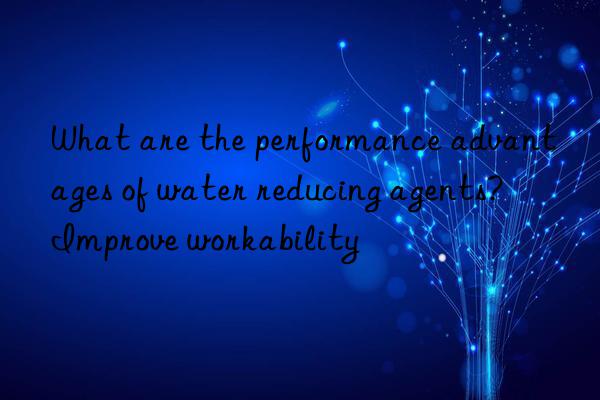
Nowadays, the requirements for concrete performance in engineering construction are constantly increasing. Water-reducing agents have become an indispensable part of concrete. Water-reducing agents have become future water-reducing agents with their excellent dispersion and dispersion retention. The development direction. It can make concrete have high fluidity even at low dosage, and have excellent properties such as low viscosity and low slump loss at low water-cement ratio, and has better compatibility with cement. Water-reducing agents have been widely used in the mainland. In the 1980s, Japan successfully developed for the first time a high-performance water-reducing agent that was completely different from NSF and MSF. It was used to improve the workability of concrete, optimize its long-term performance, and promote the high performance of concrete. Performance-based
Specifically, water-reducing agents have the following characteristics and uses:
1. High water-reducing rate and improved concrete fluidity.
2. It does not segregate or bleed, and has better performance in maintaining the slump of concrete. It can achieve basically no loss within 120 minutes. It is used to improve the construction performance of concrete and facilitate transportation and pumping.
3. Ability Formulate ultra-high-strength and ultra-durable concrete to improve the durability of concrete and achieve a century-old life of concrete.
4. The water-reducing agent has good compatibility with cement, admixtures and other admixtures, and improves admixtures. dosage, save resources and energy, and reduce environmental load.
5. It can effectively reduce the early adiabatic temperature rise of concrete, which is more beneficial to large-volume concrete, reducing concrete shrinkage and improving concrete volume stability.
6. Significantly reduce the shrinkage of concrete, significantly reduce cracking, and improve the impermeability of concrete. Experiments have shown that the 28-day shrinkage of C60 concrete produced using Sika salt admixture is about 20% smaller than the shrinkage of concrete produced using ordinary naphthalene series admixtures.
7. Excellent slump protection, the concrete mixture can maintain the slump for a long time, and ordinary concrete can achieve 2h concrete slump and fluidity without any loss.
8. Concrete has good cohesion, homogeneity, pumpability, and is easy to construct.
9. The setting time and strength development are easy to control.
10. Low harmful ion content, improving the durability of concrete.
11. It has good compatibility with cementitious materials, which is conducive to the large-scale promotion and application of water-reducing agents.
12. The molecules are adjustable. By adjusting the molecular structure, the carboxylic acid water-reducing agent has different properties to meet different customer needs.
13. Incompatibility with other admixtures. Almost most salt superplasticizers, due to their unique molecular structure, are difficult to be compatible with other superplasticizers, especially naphthalene series superplasticizers. When using salt superplasticizer to configure concrete, mixing naphthalene series will reduce the initial slump of concrete or rapidly reduce the slump of concrete. Therefore, it is strictly prohibited to mix naphthalene series superplasticizer during use. This is also an important factor that limited the promotion of salt superplasticizer before it became popular.
14. It is easy to store. For long-term storage of salt admixtures, it is recommended to use fiberglass, PE or stainless steel tanks. Iron tanks are not suitable.
High-efficiency water-reducing admixtures are favored by concrete workers for their excellent performance. They have been well promoted and applied in the Chinese market in recent years, especially in railways, highways, bridges and some image projects.
Application of water-reducing agent in special concrete
High-strength concrete
It is a high-efficiency water-reducing agent with high water reduction and good concrete slump maintenance, so that It has become an indispensable high-quality water-reducing agent for high-strength (≥C60) concrete. It is precisely because of the continuous improvement in the requirements for the strength and workability of concrete that some commercial concrete companies use additives for higher grade concrete (≥C40), while other grades use ordinary aliphatic additives.
Self-compacting concrete
Self-compacting concrete should have the following characteristics: (1) Newly mixed concrete must have high fluidity, good cohesion, stability and It is homogeneous, does not stratify, does not separate and bleed, and has good performance in penetrating steel gaps. It must have excellent vibration-free self-compacting performance, and the concrete should have a high degree of "softness". (2) After hardening, concrete must have high strength, uniform surface and interior, good dimensional stability, freeze-thaw resistance, carbonization and corrosion resistance, and extremely high durability.
Generally speaking, the water-reducing agent has strong plasticity retention and can effectively control the loss of slump over time without having much impact on the hardening time of concrete. It has a large reinforcing effect and has shrinkage resistance, which can more effectively improve the impermeability and frost resistance of concrete. Therefore, it can improve the durability of concrete to a greater extent than other high-efficiency water-reducing agents. </p



 微信扫一扫打赏
微信扫一扫打赏
